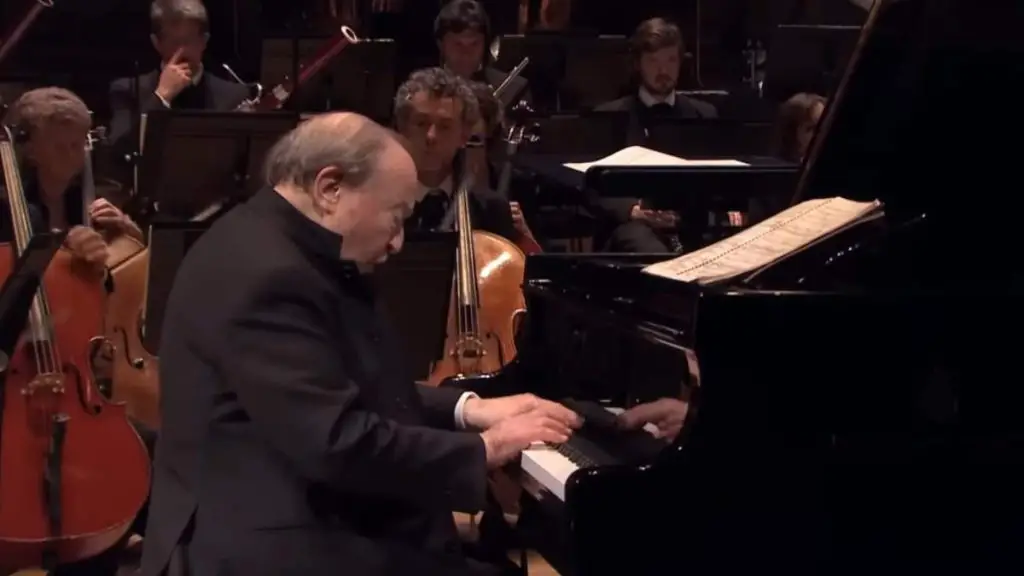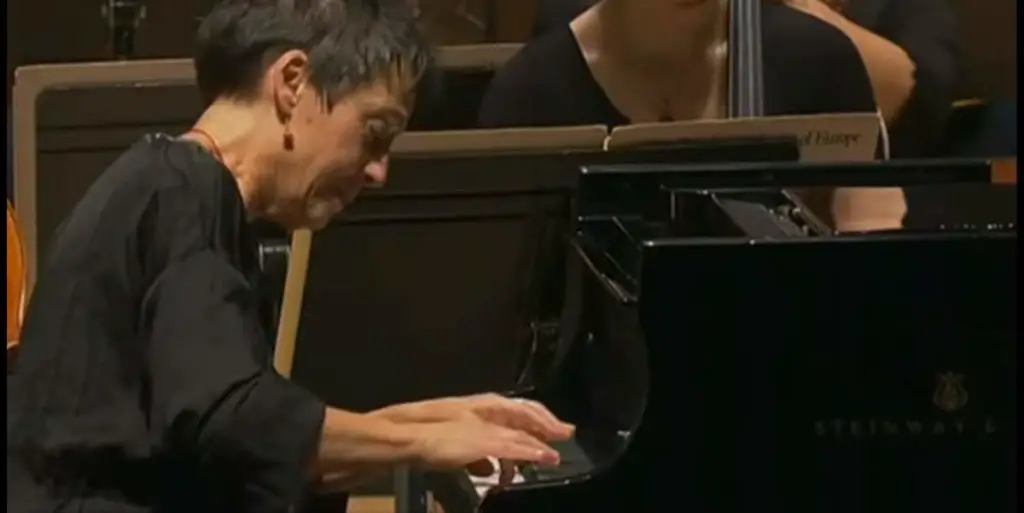Accompanied by the NDR Elbphilharmonie Orchestra, the Swiss pianist Francesco Piemontesi performs Wolfgang Amadeus Mozart’s Piano Concerto No. 27 in B-flat major, K. 595. First performed early in 1791, the year of his death, it is Mozart’s last piano concerto. Conductor: Herbert Blomstedt. This performance was recorded on December 11, 2020, without a live audience.
Mozart’s Piano Concerto No. 27
Wolfgang Amadeus Mozart’s Piano Concerto No. 27 in B-flat major, K. 595, stands as his final work in the piano concerto genre. Completed in 1791, the same year as his death, this concerto captures a different tone compared to his earlier pieces in the same category. While many of Mozart’s previous piano concertos were brimming with youthful exuberance or dramatic intensity, No. 27 exudes a kind of mature serenity and poise. This suggests a composer who has come full circle in his life, possessing an understanding of both musical form and emotional expression that could only be acquired through years of experience.
When analyzing the musical landscape of this concerto, it’s crucial to recognize Mozart’s evolving relationship with the piano. During the time this piece was composed, Mozart had already suffered numerous setbacks in his personal life, including deteriorating health and financial difficulties. The popularity of the piano was also on the rise, gradually replacing the harpsichord, and Mozart’s compositional style adapted to this more expressive instrument. His approach to the piano as not just an accompanying instrument but a robust, dynamic participant in the musical dialogue is amply demonstrated in this work.
The concerto’s orchestration is refined but not overly elaborate, featuring a relatively modest ensemble of woodwinds, horns, and strings. The clarity of the orchestration allows for a balanced partnership between the piano and the orchestra, creating ample room for nuanced dialogues and exchanges. This setup enhances the work’s sense of intimacy and interiority, making it more of a personal statement than a grandiose display of technical prowess or compositional complexity.
Thematically, the concerto does not shy away from exploring both light-hearted and more contemplative realms. Yet, it maintains a certain kind of aloofness, almost as if Mozart is taking a step back to reflect on his life and art. That’s not to say that the piece lacks melodic beauty or sophistication. The harmonies are still intricate, and the musical development is as robust as one would expect from Mozart; it’s just that everything seems to be encapsulated in a mood of graceful restraint.
Mozart’s Piano Concerto No. 27 is a work that encapsulates the essence of a composer at a particular stage of life and artistic development. It represents a coming of age, not in the sense of youthful discovery, but in terms of achieving a mature perspective that can only come from lived experience.
Movements
There are three movements. With start times in the video:
- Allegro 00:44
- Larghetto 15:02
- Rondo. Allegro 22:00
1. Allegro
The first movement of Mozart’s Piano Concerto No. 27 in B-flat Major, K. 595, is set in the concerto’s home key of B-flat major and follows the traditional sonata-allegro form, which is a standard for first movements in classical concertos. However, there’s something notably different in the approach and atmosphere of this movement compared to the more exuberant or tempestuous first movements found in some of Mozart’s earlier concertos. The tempo marking is “Allegro,” but the overall sentiment of the music leans more towards lyrical expression and a kind of poised equanimity rather than overt drama or virtuosic display.
From the outset, the main theme introduced by the orchestra is both elegant and simple, almost bordering on the pastoral. The piano entry is equally subdued, maintaining an atmosphere of gentle sophistication. Here, you’ll find less of a contrast between the themes presented by the orchestra and those elaborated upon by the piano. This creates a seamless flow of musical ideas, emphasizing the conversational aspects between the solo instrument and the orchestra. The thematic material is melodically rich but not overly complex, suggesting a focus on the beauty of the melody and the clarity of expression.
The development section, where themes are traditionally expanded and explored, is somewhat concise but highly effective. Mozart doesn’t dwell excessively on harmonic explorations or dramatic tensions; rather, he moves efficiently to the point, emphasizing cohesion and balance. When the recapitulation arrives, bringing back the main themes, there’s a sense of homecoming but also of retrospection. It’s as if the movement encapsulates a lifetime’s worth of experiences but distills them into expressions of resigned contentment.
In terms of piano technique and orchestration, this movement is less demanding than some of Mozart’s earlier works in the genre. However, what it might lack in virtuosic dazzle, it more than makes up for in the demand for emotional depth and subtlety from the soloist. The dialogue between the piano and the orchestra is intimate, requiring a level of interpretive finesse to capture the nuances and subtleties that make this movement so compelling.
2. Larghetto
The second movement of Mozart’s Piano Concerto No. 27, K. 595, is a profound testament to Mozart’s gift for capturing a wide emotional spectrum within a relatively concise musical frame. Marked “Larghetto,” the movement is set in the key of E-flat major, which offers a warm contrast to the B-flat major of the outer movements. This shift in tonality often serves to deepen the emotional texture of a piece, and it’s no exception here.
The mood of the Larghetto is introspective, imbued with a certain wistfulness that gives it a touching vulnerability. It’s a reminder that Mozart’s works often reach their most profound depths when the composer’s music seems to turn inward. In this movement, you find less of the dialogic back-and-forth between piano and orchestra that typifies many other Mozart piano concertos. Instead, the piano takes on a more dominant role, serving almost as a monologue or soliloquy set against a subdued orchestral backdrop.
In terms of the melodic lines, they are gracefully long-spun, featuring the kind of melodic arches for which Mozart is renowned. Each phrase feels like a carefully considered thought, imbued with a sense of longing or nostalgia. Mozart’s handling of harmony is equally subtle and serves to reinforce the deeply expressive nature of the music. The harmonies are largely conventional but applied in such a way as to maximize their emotional impact, such as in the use of deceptive cadences or unexpected modulations that add layers of emotional complexity.
Despite its quietude and relatively restrained orchestration, the Larghetto is a technically demanding piece for the pianist. The challenge here is less about virtuosic runs or complex figurations and more about capturing the nuanced emotional shifts that permeate the movement. It requires a keen sensitivity to touch, phrasing, and dynamics. This isn’t just a matter of hitting the right notes; it’s about imbuing each note with the correct shade of emotion, making the movement a demanding endeavor for even seasoned pianists.
3. Rondo. Allegro
The finale of Mozart’s Piano Concerto No. 27
brings the work to a close with an “Allegro” that combines formal elegance with a sense of buoyancy. Returning to the concerto’s home key of B-flat major, this Rondo movement showcases the more light-hearted side of Mozart, albeit with a veneer of mature refinement. Unlike the deeply introspective second movement, the final Allegro seems to re-engage with the world in a manner that’s both joyful and somewhat restrained.
The Rondo form, characterized by the recurrence of a main theme interspersed with contrasting episodes, is particularly suited for displaying both unity and variety. The principal theme of this movement is a memorable, almost dance-like melody that is easy on the ears but sophisticated enough to allow for artistic elaboration. Each time this theme returns, it acts as a musical anchor, providing a sense of familiarity and cohesion.
The contrasting episodes in between the recurrences of the main theme offer opportunities for both the pianist and the orchestra to indulge in a bit of musical exploration. These episodes often introduce new thematic material or variations on earlier themes, sometimes venturing into different keys for added color and interest. Yet, throughout these explorations, the music never loses its poise or becomes overly complicated. Mozart manages to maintain a perfect balance between innovation and tradition, between the quest for fresh ideas and the pull of familiar comforts.
From a technical perspective, the third movement doesn’t demand extravagant virtuosity from the pianist, but it does require a keen sense of timing, phrasing, and articulation. The piano’s interaction with the orchestra is more like a congenial conversation among equals rather than a competition for the spotlight. This mutual respect between the solo instrument and the orchestra aligns well with the overall mood of the concerto, which is one of mature reflection rather than youthful bravado.
Sources
- Piano Concerto No. 27 (Mozart) on Wikipedia

